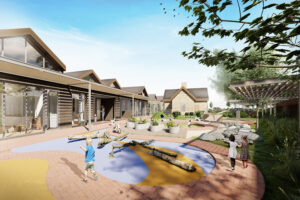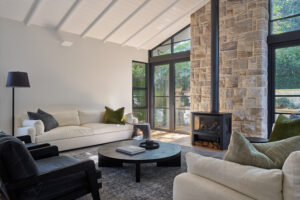Passive Cooling
Passive cooling is a non-mechanical way to cool your home naturally and is the least expensive means of cooling, in both a financial and environmental sense. It uses a range of strategies, such as orientation, ventilation, windows, shading, insulation and thermal mass. However, the essential element of passive cooling is air movement. It cools people by increasing evaporation and requires both breeze capture and fans for backup in still conditions.
Louvres incorporate passive cooling into the C&P House at North Curl Curl, catching the ocean breeze to create gentle cross ventilation throughout the house.

At C&D House in Dee Why, a green courtyard was created to provide a natural evaporative cooling effect.

Passive Heating
Passive heating is the least expensive way to heat your home. It leverages a building’s materials and orientation to trap and store heat from the sun, maximising exposure to the sun in winter while minimising it in summer. The building’s thermal performance is optimised to retain heat in the cooler months and deflect it in summer. This approach requires careful attention to the northern orientation of daytime living areas, as well as appropriate use of glass areas on northern façades, passive shading, thermal mass for storing heat, insulation and draught sealing, and climate-appropriate glazing solutions.
Passive heating was incorporated into the renovation of Manly heritage home K&C House. Taking advantage of the home’s north-facing orientation, the design captures solar heat and stores it in concrete during winter.

In summer, shading shields the house from the heat of the sun and further cooling is provided by the concrete due to its high thermal mass – meaning that it efficiently absorbs and releases heat. Concrete warms quickly in the sun but remains cool in the shade.
Solar Shading
Solar shading controls the amount of heat and light admitted into the building from the sun, significantly reducing the need for air conditioning. Eaves and awnings are typical examples. Passive shading is often a simple and inexpensive way to cool your home; however, to be effective it has to work with a building’s orientation and the changing angle of the sun throughout the year. For northern elevations, eaves are the simplest and least expensive shading method. Fixed horizontal shading devices can also maximise solar access to north-facing glass throughout the year without requiring any user effort.
A timber batten brise soleil provides solar shading for C&P House at North Curl Curl. This method allows the low winter sun to penetrate deep into the home, providing natural light and warmth, while preventing overheating in summer when the sun is high.

If you would like to know more about Passive Cooling, Passive Heating and Solar Shading, please don’t hesitate to contact us. We are experts in the sustainability field and love to answer your questions, especially our very own, Certified Passive House Designer and Consultant, Carole Huard!







